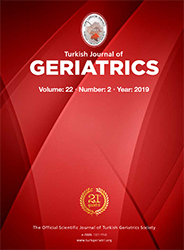Materials and Method: Between January 2005 and March 2018,98 patients underwent surgery for acute arterial occlusion owing to chronic peripheral arterial disease were evaluated according to the Fontaine Classification, demographic characteristics, concomitant disease, physical examination findings, type of surgery and amputation and mortality rates, and its causes were analyzed.
Results: None of the patients (n=98) presented with Fontaine stage I disease. Because peripheral arterial disease is usually observed in the elderly population, elderly patients with several health problems at advanced age are more likely to undergo extremity amputation. It can be reduced by including the ankle brachial index examination in any outpatient clinic. Other stages of the disease were also evaluated in detail.
Conclusion: ABI examination should be included in the systemic examination for patients aged>70 years. Currently, lumbar hernia, osteoporosis or osteoarthritis are also observed in such patients, and the clinical signs of peripheral arterial disease are masked. Due to these diseases, the diagnosis of peripheral arterial disease is delayed.
Keywords : Peripheral arterial disease; Ankle Brachial Index; Amputation
